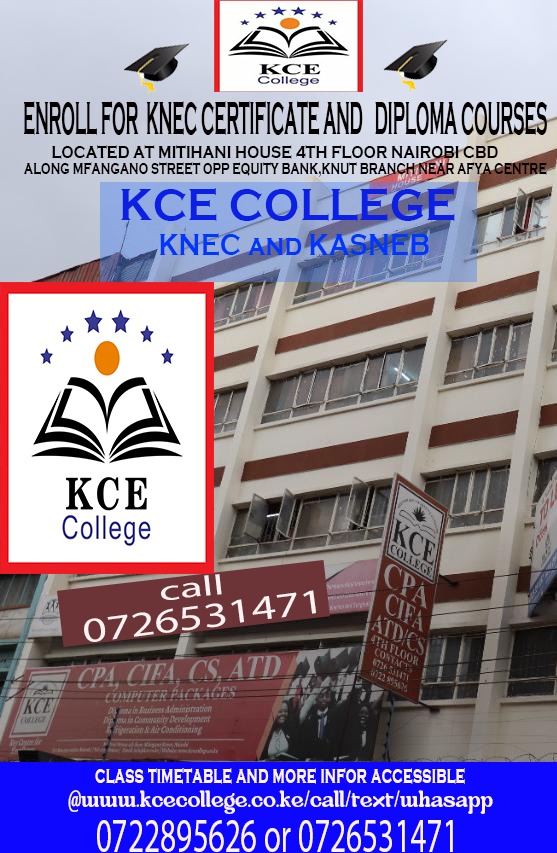Computational Mathematics July 2016 Past Examination Question Paper – KNEC
This Past Paper examination was examined by the Kenya National Examination Council (KNEC) and it applies to the following courses
-
Diploma in Information Communication Technology – Module I
Note: To easily navigate through the KNEC Past Examination Paper Pdf below, Mobile phone users are advised to use Mozilla or Chrome browsers
THE KENYA NATIONAL EXAMINATIONS COUNCIL
DIPLOMA IN INFORMATION COMMUNICATION TECHNOLOGY
MODULE I
COMPUTATIONAL MATHEMATICS
3 hours
(i) State the additive law of probability.
(ii) A manufacturer assembles watches from four independently produced components each of which has a probability of 0.01 of being defective.
Determine the probability that a watch selected at random is defective. (4 marks)
Given two matrices: 3 2′ ‘3 2′
X = 2 5 and Y = 4 -1
(b)
(X xY) x (X x Y)-1 =
O’
1
(7 marks)
Table 1 shows the total sales of different products from Mwango wholesalers for three years. Use it to answer the questions that follow.
Year Wheat Flour Sugar Cooking Oil
2007 185 100 85
2008 199 140 110
2009 225 165 150
Table 1
(i) Present this information in a component bar chart by year.
(ii) Use a pie chart to present the total sales for the year 2009.
Define each of the following terms:
(i) finite difference as used in numerical analysis;
(ii) range as used in measures of dispersion.
Explain each of the following terms as used in probability theory:
(i) outcome set;
(ii) independent events.
(i) Using binomial theorem, expand the expression (x + y) 6 in descending of y.
(ii) Using the two’s complement method, determine 15-33.
Using the graphical method, solve the following set of simultaneous equation. 3x + 5 y = 30 2x + 2y = 16
Define the term parity bit as used in data transmission. (2 marks)
Explain tw o types of parity bits as used in data communication. (4 marks)
Given the following sequence of numbers 12, 28, 50, 78, 112 and 152.
(i) Create the forward difference table for the sequence. (2 marks)
00 2
Using the relationship ax + bx + c, compute the values for x = 1,2, 3, to represent the values in the first and subsequent rows. 4, 5 and 6 (6 marks)
(iii) Create the difference table with the general terms. (3 marks)
(iv) Determine the values of a, b and c. (3 marks)
(a) Define each of the following terms as used in mathematics:
(0 absolute error; (2 marks)
(ii) linear interpolation. (2 marks)
(b) Explain three properties of standard deviation as a measure of dispersion. (6 marks)
(c) Given that set A = {l, 2, {2}}, state whether the following statements are true or false.
(i) (1 mark)
(ii) {{2}}c^ ; (1 mark)
(iii) {2}<E/f; (1 mark)
(iv) {{‘}}£ (1 mark)
(d) Table 2 shows the age distribution of tourists who visited a certain game park on a
certain day. Use it to answer the questions that follow.
Age 0-20 20-40 40-60 60-80 80-100
Frequency 25 42 64 40 29
Tabic 2
Determine each of the following measures about the age distribution of the tourists:
(i) the median age; (3 marks)
(ii) the mean age. (3 marks)
(a) Outline four types of bias that could occur during data collection. (4 marks)
(b) Describe each of the following logic gates: (i) NAND; (2 marks)
(ii) NOR; (2 marks)
(iii) XOR. (2 marks)
(c) Differentiate between the terms rounding off and truncating numbers as used in mathematics. (4 marks)
(d) In a certain bank, customers arrive randomly at an average rate of 3.4 customers per minute. Assuming that the customer arrivals form a Poisson distribution, determine the probability that in any particular minute:
(i) no customer arrives; (2 marks)
(ii) exactly one customer arrives; (2 marks)
(iii) two or more customers arrive. (2 marks)
8. (a) Outline three characteristics of the normal probability distribution. (3 marks)
(b) Differentiate between the terms skewness and kurtosis as used in measures of dispersion. (4 marks)
(c) Certain luxury cars are manufactured in 4 models, 12 colours, 3 engine sizes and 2 transmission types.
(i) Determine the number of distinct cars that can be manufactured. (2 marks)
(ii) If one of the available colours is blue, determine the number of different blue
luxury cars that can be manufactured. (2 marks)
(d) Below are two Boolean expressions:
I. – py q
II. (xV y)A -ii
(i) Use logic gates to represent each expression; (5 marks)
(ii) Daw a truth table for each logic gates in (i)
